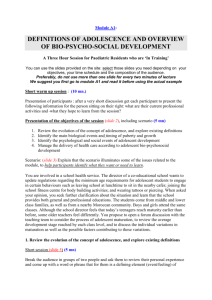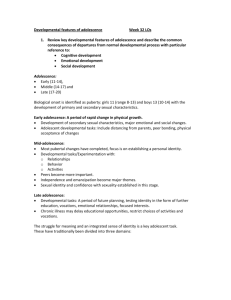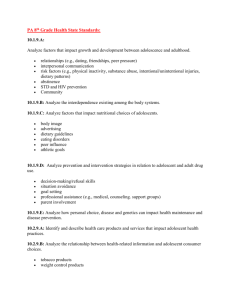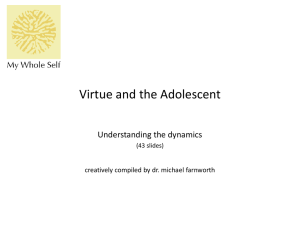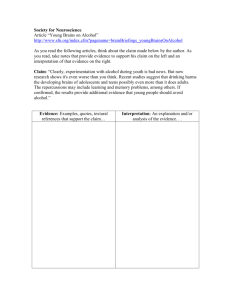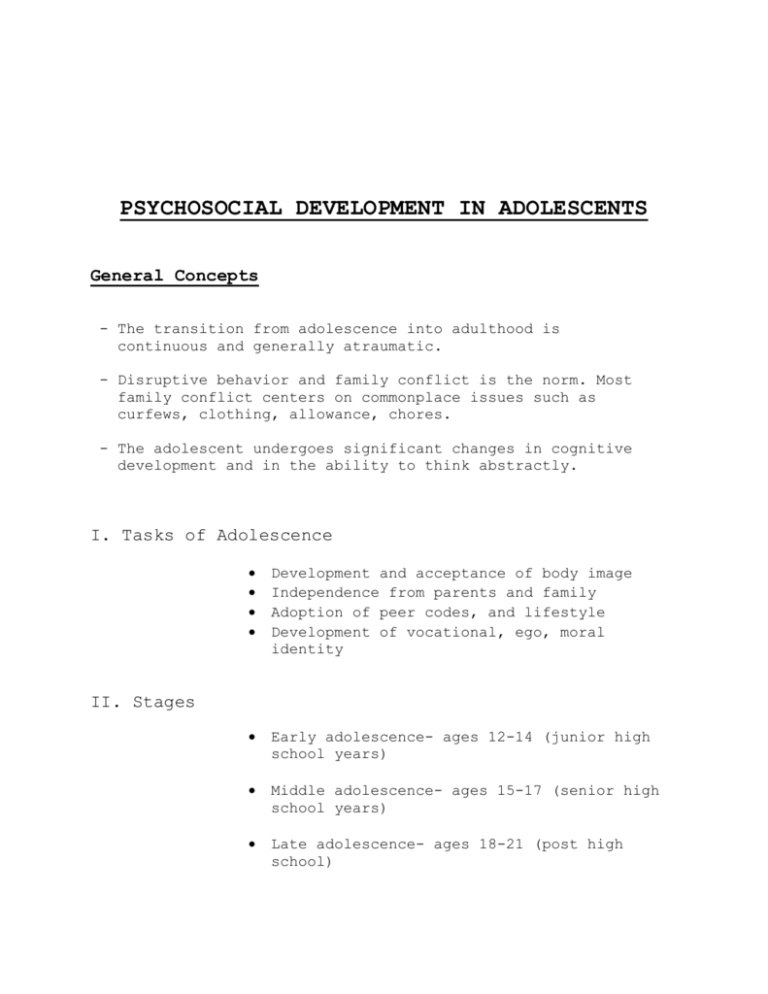
PSYCHOSOCIAL DEVELOPMENT IN ADOLESCENTS
General Concepts
- The transition from adolescence into adulthood is
continuous and generally atraumatic.
- Disruptive behavior and family conflict is the norm. Most
family conflict centers on commonplace issues such as
curfews, clothing, allowance, chores.
- The adolescent undergoes significant changes in cognitive
development and in the ability to think abstractly.
I. Tasks of Adolescence
Development and acceptance of body image
Independence from parents and family
Adoption of peer codes, and lifestyle
Development of vocational, ego, moral
identity
Early adolescence- ages 12-14 (junior high
school years)
Middle adolescence- ages 15-17 (senior high
school years)
Late adolescence- ages 18-21 (post high
school)
II. Stages
Early Adolescence
1. Puberty - This period is marked by the
changes, which accompany the onset and process
of the physical changes of growth and
development.
2. Behavior - common to early adolescents
include: self-centered focus, preoccupation
with physical development, questioning of
“normality” (Am I normal?) And initiation of
independence/dependence struggle.
3. Body image - Preoccupation with changes in
body development and maturation. Frequent
comparison of one’s own body with that of
others. Increased interest in sexual function
(Lots of time in the bathroom!) Concern over
perceived deficits (“My penis is not large
enough.”) Comparison of self with perceived
ideal (I’m not thin enough.)
4. Independence-dependence
Decreased interest and willingness to
participate in family activities.
Desire to be with group family may create a
“void” which may manifest in daydreaming, or
perception of isolation in some teens. This
maybe demonstrated by wide swings of mood,
or self-centeredness.
Teen may demonstrate embarrassment of
parents and family.
5. Peer-group
“Best friends”- solitary same sex
friendships, prefer same sex groups
Involvement with opposite sex in “safe”
settings (i.e., the phone}
Public awkwardness and avoidance of
members
of opposite sex - except in
groups (boy-girl parties)
6. Identity development
Egocentricity of self-centeredness, which
is initiated by pubertal development, may
direct adolescent thoughts to engage in
fantasy.
The adolescent may feel that others are
attentive to his/her actions and feel
“onstage”.
Unrealistic vocational goals - the early
teen lacks insight and experience that are
necessary for realistic goal formation.
Challenges to authority - reflect the need
for self-definition, often causes tension
between adolescent and adults. Often
challenges to authority are not initially
aimed at parents, rather at teachers, or
other adults in authority roles.
Value systems of early tens become
individualized, may be self-centered and
reflect the “world revolves around me”
perception of the teen. Also reflected in
an adolescent’s sense of invulnerability.
Poor impulse control secondary to lack of
insight or recognition of consequences of
behaviors.
Middle Adolescence
This period is characterized by the increased
importance and role of the peer group.
1. Puberty – has almost been completed.
2. Behavior - increasing importance of independence/
dependence issues and emergence of realistic
vocational goals also characterize this stage.
3. Body Image
By middle adolescence, most teens have
experienced the majority of pubertal changes.
General acceptance of body image, but focus
becomes modification of appearance (weight
loss, cosmetic changes - e.g. contact lenses).
The adolescent with pubertal delay may demonstrate
significant concern over perceived abnormality.
Adolescent with disfiguring injury or illness
may continue to have primary focus on body image.
4. Independence-dependence
Some teens may adopt a rejection of parental and
family value systems in favor of value system of peer
group.
Significant decrease in interests and activities of
family in favor of peer activities.
Conflicts center around curfews, chores, expected role
within family.
Very “black and white” issues.
5. Peer-group
Assume major role in adolescent’s life
Intense need to feel accepted or “belong”
Fear of “being different”
Group dictates behaviors, dress and activities
Code of group conduct extends to sexual activity, drug
use, and other “illicit” behaviors
Exclusion of nongroup members or others who are
“different”
6.
Increased involvement with teams, clubs, gangs (need to
belong)
Identity
Increased intensity of feelings
Initially a refusal to consider feelings of others
Perception of invulnerability and recognition of skills
(deficits)
Emergence of realistic vocational goals
Late Adolescence
The tasks of identity and separation are the primary focus of
this stage of development.
1. Puberty – has now been completed.
2. Behaviors – relate to handling the tasks and
responsibilities of adulthood and more time spent in
sharing intimate relationships.
3. Body image - Most teens have accepted their body’s
development.
Some focus on cosmetic “fine tuning” (weight loss,
cosmetics, etc.)
Body image concerns may be present for the adolescent
with delayed development development, or physical
impairment/injury.
4. Independence-dependence
Many adolescents recognize that the peer group
important in middle adolescence allowed them no more
independence than did their parents and families.
Reintegration into family activities.
Reacceptance of family values and norms.
Some hesitance to accept adult responsibilities- very
little hesitance to accept desired adult privileges
(sexual activity, spending money, etc).
5. Peer-group
Friendships progress from group dominant to singular.
6.
Increased tolerance and understanding of individual
Differences.
Friendships based less on appearance and more on
mutual interests.
Decreased importance and role of peer group from
middle adolescence.
Identity
Practical vocational goals are of primary importance.
Moral, religious and sexual values are re-evaluated.
Adult characteristic behaviors include:
o Delayed gratification,
o Compromise and
o Insight gained from experience.


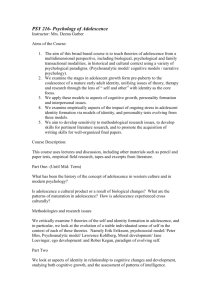


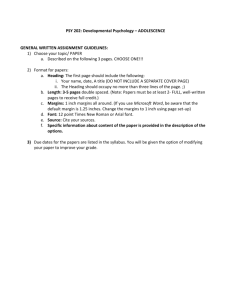
![Adolescence in 20th Century Literature and Culture [DOCX 16.08KB]](http://s3.studylib.net/store/data/006806148_1-4fb552dd69cbfa44b08b2f880802b1fe-300x300.png)
